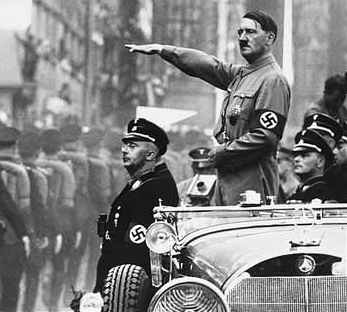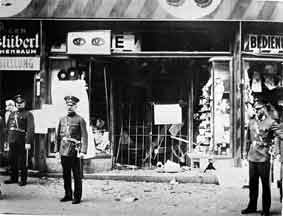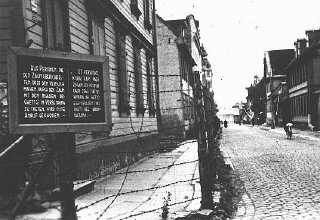
On January 30, 1933, Adolf Hitler was appointed Chancellor of Germany with a Jewish population of 556,000. The Jewish population's fate came to a change when Hitler got into power. The main paramilitary organization that carried out Hitler's commands were the SS. The Schutzstaffel (SS) was created under Hitler in 1925. They first served as guard units and later grew to form a small paramilitary formation. In March, the SS opened the Dachau concentration camp outside of Munich. This was the first concentration camp established by the Nationalist Socialist (Nazi) government. It was commanded by Heinrich Himmler which was the police president of Munich at the time. The camp was first used to imprison political oppositions and over time, other groups such as Roma, Jews, and homosexuals were also placed into this camp. Between 1933 and 1936, thousands of political prisoners were sent to concentration camps. Boycotts against Jewish-owned businesses arouse throughout the country over the course of these few years. The Nazi party declared their intention to segregate Jews from the Aryan society and believed that the Jewish population was a threat to their superior Aryan German race. Antisemitism and persecution of Jews was an important ideal for the Nazis. In September of 1935, a high point of antisemitism was reached, and the Nuremberg Race Laws were passed. These laws excluded German Jews from citizenship and prevented them from marrying anyone of German blood. This new institution also deprived Jews of their rights to vote and hold public office. The public life of a Jewish person were highly restricted and they were usually looked down upon by the Nazi Party. At the beginning of 1935, Germany began heavy military drafting and strengthened their military forces by tremendous amounts. Western nations appeased to Hitler and allowed him to march into Rhineland, a demilitarized area from the Treaty of Versailles. Many European states thought that when the dissatisfied nations get what they want, peace will be established. This theory will be soon proven wrong.
 Kristallnacht, also referred to as Night of Crystal, was a series of violent anti-Jewish protests which took place in November 9 and 10 of 1938. This pogrom occurred throughout Germany, annexed Austria, and in newly controlled Sudetenland of Czechoslovakia. During this violence, Nazi Party officials and members of the Storm Troopers of Germany stormed hundreds of synagogues and thousands of Jewish-owned businesses. Shattered glass lined German streets at the morning at the protest. Kristallnacht resulted from the assassination of Ernst vom Rath which was a German embassy official stationed in Paris. A 17 year old Jew shot the diplomat and the news erupted the German population throughout the country. On the Night of the Broken Glass, over 267 synagogues and 7500 Jewish owned businesses were destroyed throughout German states. Kristallnacht was considered the first instance where the Nazi regime incarcerated Jews on a massive scale based on racism and this event changed antisemitic policies completely for the worse. As these protests spread, units of the SS started arresting Jewish males and transferred them into concentration camps. In weeks that followed, the German government made dozens of new laws and decrees to deprive Jews of their remaining properties and given to Aryans. The Nazi regime expanded and radicalized laws aimed at entirely removing Jews from economic and social life.
Kristallnacht, also referred to as Night of Crystal, was a series of violent anti-Jewish protests which took place in November 9 and 10 of 1938. This pogrom occurred throughout Germany, annexed Austria, and in newly controlled Sudetenland of Czechoslovakia. During this violence, Nazi Party officials and members of the Storm Troopers of Germany stormed hundreds of synagogues and thousands of Jewish-owned businesses. Shattered glass lined German streets at the morning at the protest. Kristallnacht resulted from the assassination of Ernst vom Rath which was a German embassy official stationed in Paris. A 17 year old Jew shot the diplomat and the news erupted the German population throughout the country. On the Night of the Broken Glass, over 267 synagogues and 7500 Jewish owned businesses were destroyed throughout German states. Kristallnacht was considered the first instance where the Nazi regime incarcerated Jews on a massive scale based on racism and this event changed antisemitic policies completely for the worse. As these protests spread, units of the SS started arresting Jewish males and transferred them into concentration camps. In weeks that followed, the German government made dozens of new laws and decrees to deprive Jews of their remaining properties and given to Aryans. The Nazi regime expanded and radicalized laws aimed at entirely removing Jews from economic and social life. Germany eventually was able to bypass conflicts during the Munich Conference when Western countries reached a high point of appeasement for Germany. Hitler promised that Sudetenland were his last demands. However, he looked down upon the powers of the Western nations and ignored the Munich Agreement. After signing the Nazi-Soviet Nonaggression Agreement in August of 1939, Germany was guaranteed that the Soviet Union will not be interfering in their future plans of invasion. In just ten days, Germany invaded Poland, thus starting World War II in Europe. The Nazi created their first ghetto in Piotrkow Trybunalki of Poland. Ghettos were enclosed districts where the Jewish population were forced to live in. There are three main types of ghettos and they consisted of closed, open, and destruction. Over a thousand ghettos were established in the German annexed Poland state. Many European Jews were also deported to these ghettos from the West. They were isolated from the non-Jewish population and the Nazi regime found this to be essential measure to control the Jewish population. Here is an account from a survivor of the Vilna ghetto in Poland:
Germany eventually was able to bypass conflicts during the Munich Conference when Western countries reached a high point of appeasement for Germany. Hitler promised that Sudetenland were his last demands. However, he looked down upon the powers of the Western nations and ignored the Munich Agreement. After signing the Nazi-Soviet Nonaggression Agreement in August of 1939, Germany was guaranteed that the Soviet Union will not be interfering in their future plans of invasion. In just ten days, Germany invaded Poland, thus starting World War II in Europe. The Nazi created their first ghetto in Piotrkow Trybunalki of Poland. Ghettos were enclosed districts where the Jewish population were forced to live in. There are three main types of ghettos and they consisted of closed, open, and destruction. Over a thousand ghettos were established in the German annexed Poland state. Many European Jews were also deported to these ghettos from the West. They were isolated from the non-Jewish population and the Nazi regime found this to be essential measure to control the Jewish population. Here is an account from a survivor of the Vilna ghetto in Poland:"...they rounded up all the Jews from the city and the suburbs and they put us all in this ghetto, in this...and surrounded us with walls, and with guards, and we had to live in one...in an apartment, two to three families in a two-room apartment."
As the Nazi regime stretched across Europe, the administration began deporting Slavic people and they planned to provide more living space for German expansion. The Aryan racial empire were so important that Hitler began to use a racial program. In 1941, the Einsatzgruppen special forces were established and they were in charged of overseeing the ghettos. After invasions of countries, these special forces would round up the Jewish population and used many various methods to kill them. One method include mobile killing units. They round up Jews in their villages, execute them, and bury them in mass graves dug by victims before they got killed.
 As the World War II dragged on, Hitler was more eager to exterminate the whole Jewish population and decided to use death camps and concentration camps to increase the killing rates. This was known as the Holocaust as it was a massive genocide and extermination of the Jewish people. Germany would always deport massive numbers of Jews from their conquered countries to these death camps in Poland. The lead to the Final Solution decided at the infamous Wannsee Conference in 1942 when it was ordered that all Jews in Europe be killed in extermination camps. German were required to design and produce ovens and gas chambers that would enable the mass murders to be carried out quickly and cleaning without involving German personnel. They constructed gas chambers to have maximum killing efficiency. At the Auschwitz camp, the extermination camp had four gas chambers and over 6,000 Jews were gassed there each day. Each death camp was expected to make a profit and each camp was in competition with the others to see which could make the most. The most deadly and largest of these camps were at Auschwitz-Birkenau, Belzec, Sobibor, and Treblinka. About seven to eight million Jews and Roma were killed in these death centers by either asphyxiation with poison gas or by shooting. Only a small fraction of those imprisoned in Nazi camps survived the horror. Here is a small account from how Bart Stern, a Hungarian Jew, survived to be liberated in the Auschwitz camp:
As the World War II dragged on, Hitler was more eager to exterminate the whole Jewish population and decided to use death camps and concentration camps to increase the killing rates. This was known as the Holocaust as it was a massive genocide and extermination of the Jewish people. Germany would always deport massive numbers of Jews from their conquered countries to these death camps in Poland. The lead to the Final Solution decided at the infamous Wannsee Conference in 1942 when it was ordered that all Jews in Europe be killed in extermination camps. German were required to design and produce ovens and gas chambers that would enable the mass murders to be carried out quickly and cleaning without involving German personnel. They constructed gas chambers to have maximum killing efficiency. At the Auschwitz camp, the extermination camp had four gas chambers and over 6,000 Jews were gassed there each day. Each death camp was expected to make a profit and each camp was in competition with the others to see which could make the most. The most deadly and largest of these camps were at Auschwitz-Birkenau, Belzec, Sobibor, and Treblinka. About seven to eight million Jews and Roma were killed in these death centers by either asphyxiation with poison gas or by shooting. Only a small fraction of those imprisoned in Nazi camps survived the horror. Here is a small account from how Bart Stern, a Hungarian Jew, survived to be liberated in the Auschwitz camp:"And it was by the greatest miracle that I survived. There was, every barrack had a little cabin in the front, which was separation where the Blockaelteste, the Blockaelteste meant he was the, the chief of the, of the, of the barrack, and every such cabin had all the breadboxes, the bread was supplied, brought in with a box with a lock and nobody could get to it. That door, the hinge of the box was already torn off, and I was hiding in that box upside down. Here he comes in to search, he even kicks it, but luckily it gave. I was so skinny, it gave. I could see the...and I was sure this is it. This is how I remained alive. But when they already left, the Germans, about an hour they, they left, there was no sign of Germans, I wanted to go back to the barracks, but the Poles, the, the Ukraine, who were not taken on the death march, they wouldn't let me in. So I was hiding out in the heap of dead bodies because in the last week when the crematoria didn't function at all, the bodies were just building up higher and higher. And I sneaked into, among those dead bodies because I was afraid they'd come back or something. So there I was at nighttime, in the daytime I was roaming around in the camp, and this is where I actually survived, January 27, I was one of the very first, Birkenau was one of the very first camps being liberated. This was my, my survival chance."
 Near the end of the war, SS guards moved camp prisoners by train or on forced marches, known as death marches, in an attempt to prevent the Allied from liberating the prisoners. At the start of 1945, many extermination camps in Poland were being liberated and the Jewish population finally were freed out of the wrath of the Nazi regime. In the aftermath of the horrible Holocaust, 2 out of every 3 European Jew were murdered. The crimes committed during the Holocaust by the Nazi regime was very devastating and it destroyed many Jewish communities entirely.
Near the end of the war, SS guards moved camp prisoners by train or on forced marches, known as death marches, in an attempt to prevent the Allied from liberating the prisoners. At the start of 1945, many extermination camps in Poland were being liberated and the Jewish population finally were freed out of the wrath of the Nazi regime. In the aftermath of the horrible Holocaust, 2 out of every 3 European Jew were murdered. The crimes committed during the Holocaust by the Nazi regime was very devastating and it destroyed many Jewish communities entirely.
